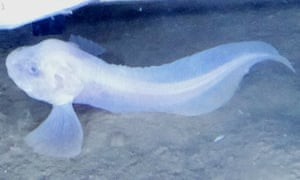Three New Species of Fish that Melt at the Surface of the Sea
Recently, three new species of fish have been discovered in the Pacific Ocean. They are, for now, being referred to as the pink, the blue, and the purple Atacama snailfish, named for their coloring and the area of the ocean in which they were found: the Atacama Trench off the coast of Chile and Peru.
These snailfish are unlike most other fish ever discovered. They have translucent bodies with no scales. They also have very few bones, and what bones they do have are relatively soft. The strongest bones in their bodies are the tiny bones found in their inner ears, meant for balance, and their teeth.
The depth of the Atacama Trench is about 8,000 meters, nearly five miles down. The fish found there have bodies that are equipped to handle the extreme pressure and cold temperatures found at this depth. They live unharmed by any predators —what fish is going to swim five miles down just for a snack?— and seem to be thriving, despite being at a depth that so few other species can survive.
But when scientists brought them up to the surface so that they could study them better, something strange happened. The snailfish melted. That’s right, the fish basically fell apart. Their bodies are made out of a gooey, gel-like substance that is held together by the water pressure alone. Because of their lack of bones, the fish do not have much of a structure, and when taken out of their natural habitat, they melt apart. The pressure at this depth is about 744 atm (standard atmospheric pressure). For reference, the atm at sea level is 1, also equivalent to 14.70 pounds per square inch. This means that the Atacama snailfish live under a pressure of about 10,927 pounds per square inch. This much pressure can hold their gel-like bodies together without a problem, but when brought to the surface, they melt very quickly.
Scientists were able to preserve one specimen, and are studying it further. Unfortunately, the difficulty of attaining these fish to study them on land, outside of their natural habitat, means that learning much more about them is probably unlikely. Scientists can watch them in their natural habitat via cameras, but until the creation of a way to preserve their bodies easily at 744 atm, under more than 10,000 pounds of water per square inch, it is unlikely that we will learn much more about these translucent fish.




